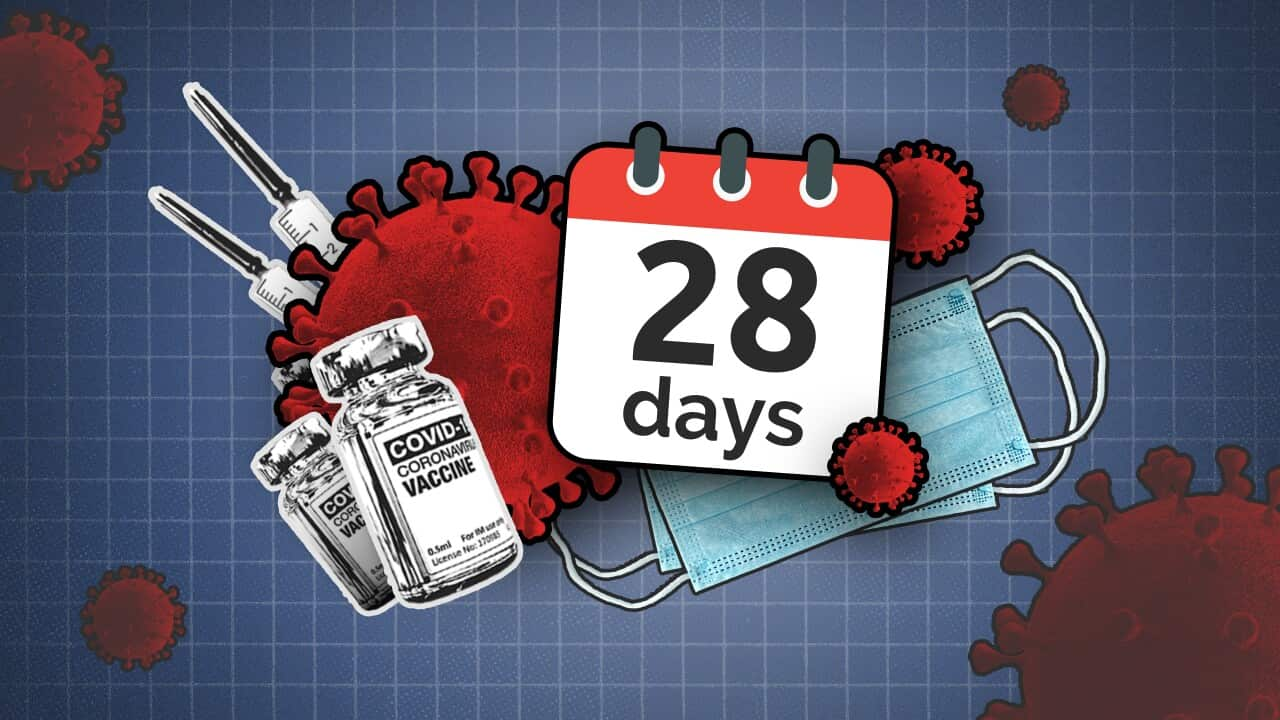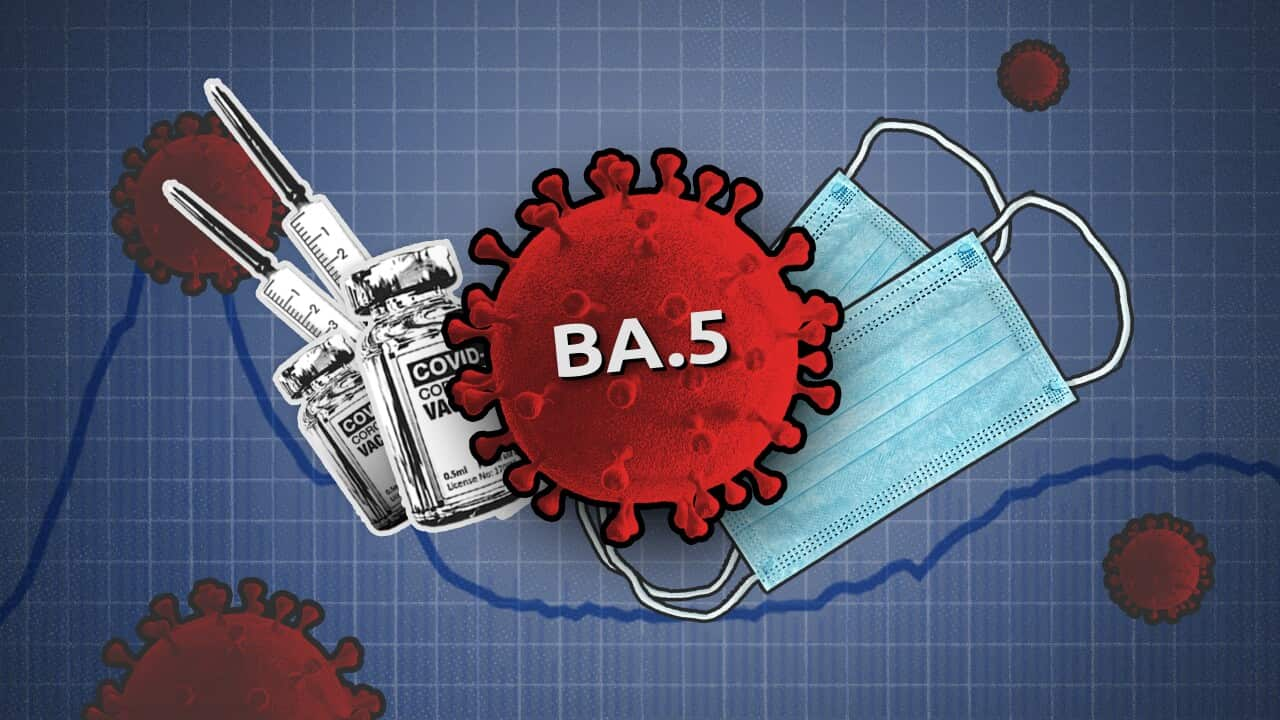Key Points
- New evidence suggests people can get reinfected with COVID-19 after just 28 days
- Australia's peak medical body has recommended formally revising the reinfection period down from 12 weeks in response
When COVID-19 emerged, those who contracted the virus were believed to be immune from reinfection for at least several months.
But as the pandemic has evolved, so too has the advice.
Last week, the national peak body for health emergencies, the Australian Health Protection Principal Committee, recommended the COVID-19 reinfection period be formally revised down from 12 to four weeks.
Why has the reinfection period been shortened?
Under previous rules, people who developed COVID-19 symptoms in the three months after recovering from their initial infection weren't required to get tested and isolate if they returned a positive result.
Professor Adrian Esterman, chair of biostatistics and epidemiology at the University of South Australia, said that's because virus particles can continue to be shed for "many weeks" after someone recovers.
But with the immunity-evading BA.4 and becoming the dominant strains in Australia, the situation has changed.
Professor Mike Toole, epidemiologist and associate principal research fellow at the Burnet Institute in Melbourne, said immune protection can diminish after as little as 28 days, leaving people open to reinfection.
"The UK now estimates that reinfections from these BA.4 and BA.5 variants are eight times more common than they were in earlier versions of both Omicron, and before that, Delta," he told SBS News.
"The US is seeing that these reinfections are occurring at a much faster rate than ever before."
Could you get COVID-19 once a month?
While it's possible to be reinfected with COVID-19 mere weeks after you've recovered from your last bout of it, Professor Esterman said it's "highly unlikely".
"Most people would get at least a month and potentially two or three months of reasonable immunity against infection," he told SBS News.
Professor Toole said while it's too early in this particular phase of the pandemic to determine how many times one person could contract the virus and how severe each infection would be, it's likely to increase their chances of getting long COVID.
"The information and understanding is still evolving, but it seems to make sense that if you get reinfected over and over, then the virus basically establishes itself in your body and in a number of organs," he said.
"Long COVID is still a poorly understood condition, but we know that or to school."
Professor Esterman said that's especially concerning, given Australia's long COVID clinics are already "inundated" with patients.
"At a minimum, you're getting 5 per cent of infected people ending up with long-term health problems, and it's probably more like 10 per cent," he said.
"Even if it's 5 per cent, it still means there are over 400,000 people with long COVID in Australia. These numbers are huge, and they're only going to get worse."
What impact will reinfections have on the healthcare system?
Australia's healthcare system is already under immense strain from the current surge in cases.
"There are more than 2,000 people in the hospital with COVID in New South Wales at the moment," Professor Toole said.
"That's an increase of almost 300 from this time last week. And Victoria, likewise."
Professor Catherine Bennett, chair of epidemiology at Victoria's Deakin University, said that's not being helped by the "really tough" flu season Australia's experiencing.
"It adds to the problem of both adding more people into the hospital system, but also other people who'd be engaging with a hospital system anyway, taking the virus with them into a high-risk setting," she told SBS News.
"Combine that with the challenge of maintaining your staff levels, with staff infection rates on the rise, along with the background infection rates in the population, then you have this terrible combination that really does put us under threat."
Professor Toole said it will continue to get worse if more measures aren't taken to reduce the virus' spread and impact on the community.
"There's a widespread belief in the population, which is nurtured by our governments, that the pandemic is in the past tense," he said.
"Everything indicates that it's quite the contrary."
How effective are boosters against BA.4 and BA.5?
While the new subvariants of Omicron are better at evading immunity gained through previous infection or vaccines, Professor Toole said third and fourth dose boosters are still a "critical" tool in limiting the spread and severity of COVID-19.
"They're the first line of protection," he said.
"If you had your second dose more than four months ago, you are not protected against Omicron (infection) at all, (but) you may have some residual protection against hospitalisation.
"If you get a third dose, you are much more protected."
Just 68 per cent of eligible Australians have received the third shot of a COVID-19 vaccine.
Professor Toole said the impact of that is reflected in hospitalisation data.
"Hospitalisations in Western Australia and the ACT are much, much lower than elsewhere," he said.
"The reason, I believe, is because their third dose booster rates are very high - 83 per cent in Western Australia and 80 per cent in the ACT, compared with just 63 per cent in Queensland, and not much better than that in NSW and Victoria."
Will masks mandates and other restrictions need to return?
While state and territory governments are resisting reintroducing mask mandates, Professor Toole said they continue to offer good protection against contracting COVID-19.
"The latest study on the effectiveness of masks shows that if an infected person is in the same room or space as an uninfected person, and they both wear masks, the risk of that uninfected person getting infected goes down 75 per cent," he said.
But Professor Toole said assessing and improving air quality in buildings and other settings also needs to be taken seriously.
He said evidence suggests public transport, gyms, bars, and retail stores have the worst ventilation of any indoor settings.
"If you're in any of those venues, you really should be wearing a mask," Professor Toole said.
Given there are already poor compliance rates in settings where mask mandates remain, Professor Bennett said she doesn't think governments introducing more rules would do very much.
Instead, she said the public needs to be given information that helps them better understand their risk of exposure, so they can take the appropriate action.
"Not case numbers that are counting up over there, or even hospitalisations, but actually expressing the information in ways that makes sense to people. What is my chance of going out and coming across the virus? How many people do I have to run into before I'm likely to have an encounter with an infectious person?"
What will it ultimately take to end the pandemic?
In the past two weeks, the number of COVID-19 cases reported to the World Health Organisation .
With issues like vaccine inequity persisting around the globe, Professor Esterman said new variants and subvariants will continue to emerge.
"It's a numbers game, the more cases there are the more mutations are," he said.
"That's all there is to it."
Even if global case numbers come down or the virus evolves into a less severe or infectious variant, Professor Esterman said COVID-19 will be "almost impossible" to eliminate.
"Our best-case scenario is that we live with it, that its death rate is no worse than seasonal influenza, we try and get on top of long COVID, which is much worse than what you get from seasonal influenza, and we keep updating vaccines," he said.
But unlike the flu, Professor Bennett said it won't be restricted to the colder months.
"We'll be dealing with this all year round for some time yet," she said.
"The glimmer of hope on the horizon are those next-generation that might give us a better degree of protection against reinfection and/or infection with the Omicron subvariants, and one that might last for a longer period."
Additional reporting by Claudia Farhart













